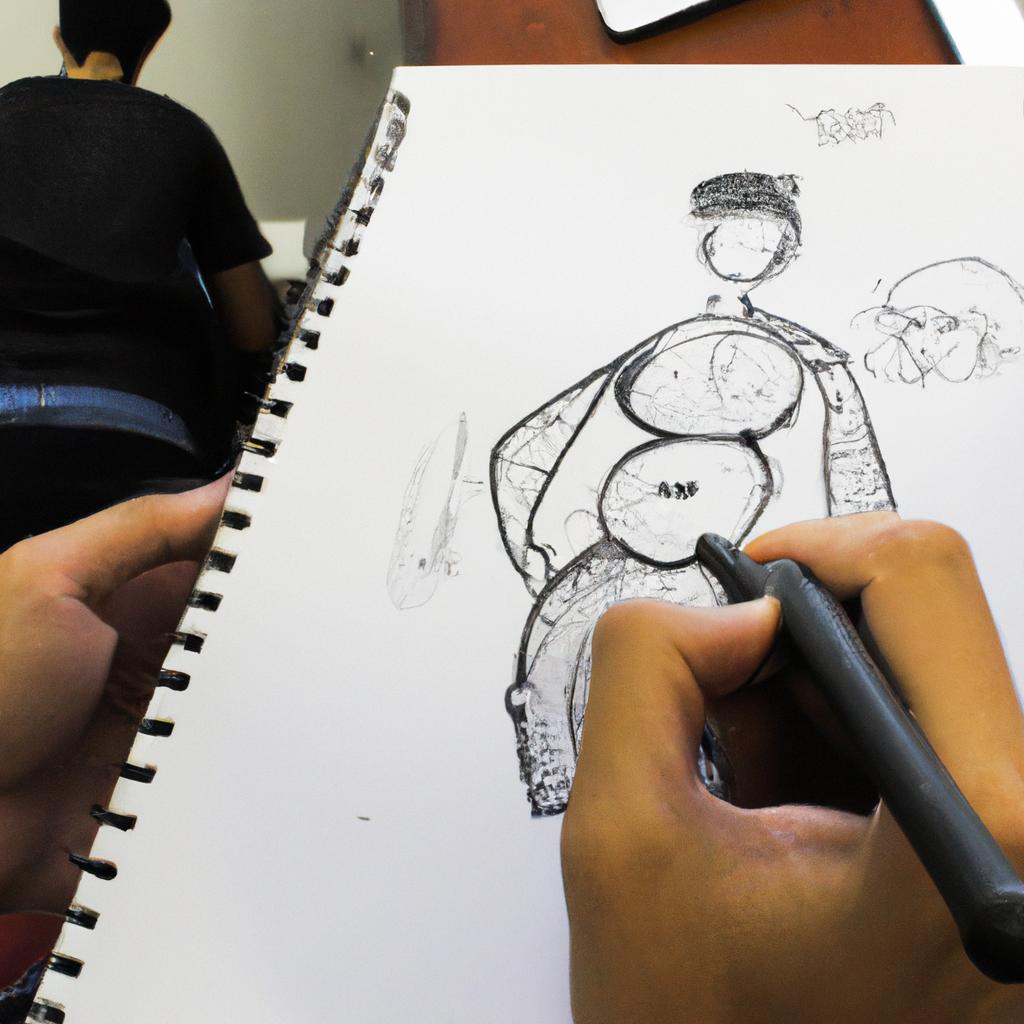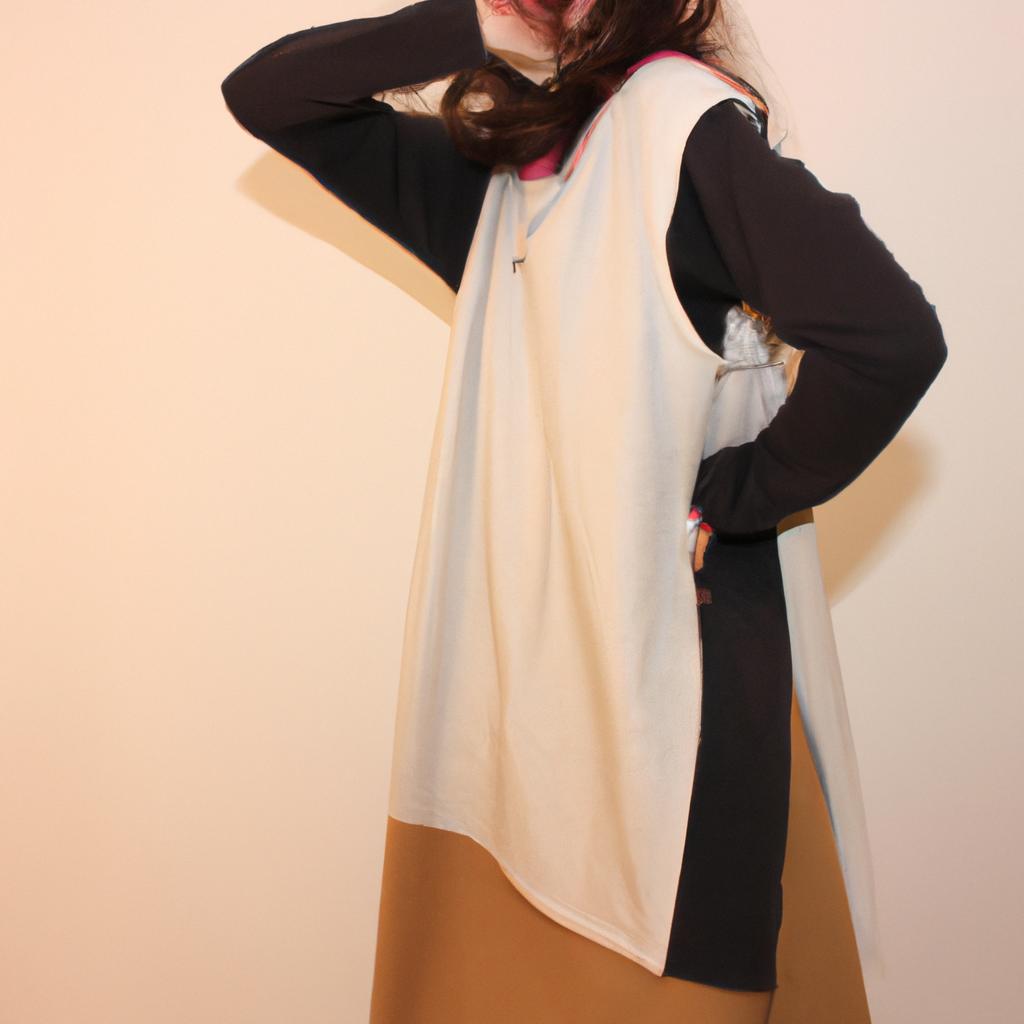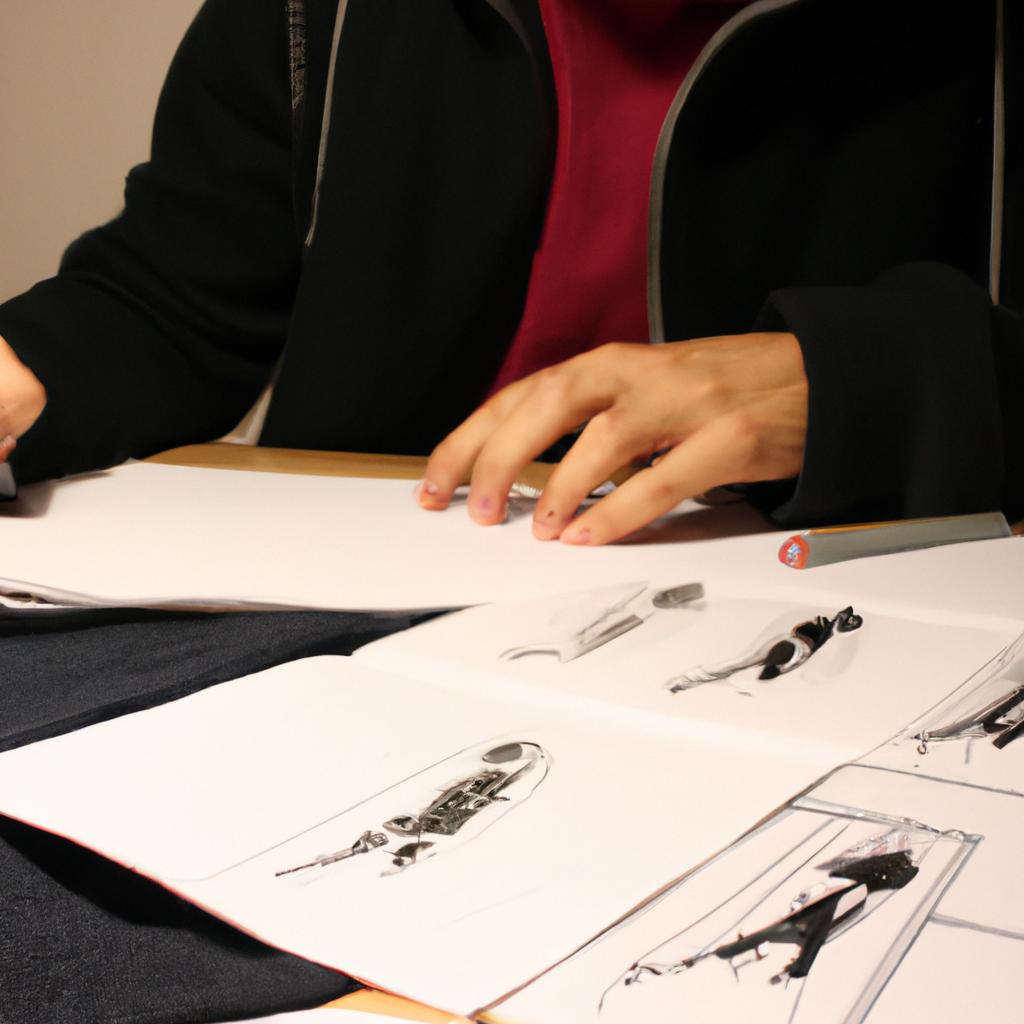The world of arts and illustration is a vast playground for creativity, where artists employ various techniques to bring their imagination to life. One crucial aspect that plays a significant role in enhancing visual appeal and conveying emotions is color theory. By understanding the principles of color theory, artists can effectively create compelling character designs that resonate with viewers on a deeper level. For instance, imagine a hypothetical scenario where an artist wants to depict a fierce and powerful superhero character. Through careful consideration of color choices, such as using bold shades of red and black, the artist can visually communicate strength and intensity.
Color theory forms the foundation upon which artists build their compositions, allowing them to manipulate colors in ways that evoke specific moods or highlight particular characteristics within their characters. Through the study of color harmony, contrast, and symbolism, artists gain insight into how different hues interact with one another and influence the overall perception of an artwork. This knowledge empowers them to make deliberate decisions when designing characters – from selecting complementary colors that enhance each other’s impact, to utilizing contrasting tones that create dynamic visuals.
The importance of color theory extends beyond mere aesthetics; it has psychological implications as well. Different colors have been shown to evoke distinct emotional responses in humans due to cultural associations and personal experiences. Artists who Artists who understand color theory can harness this psychological impact to evoke specific emotions within their viewers. For example, warm colors like red and orange are often associated with energy, passion, and excitement, making them suitable for characters with fiery personalities or intense abilities. On the other hand, cool colors such as blue and green can convey calmness, tranquility, or even a sense of mystery, which may be ideal for characters with more serene or enigmatic traits.
Furthermore, color symbolism plays a significant role in character design. Certain colors have cultural or symbolic meanings attached to them that can enhance storytelling and character development. For instance, using white to depict purity and innocence or black to represent darkness and power can add depth and complexity to a character’s visual representation.
In conclusion, color theory is an essential tool for artists in creating captivating character designs. By understanding how colors interact with one another and the emotional responses they elicit from viewers, artists can effectively communicate the desired traits and qualities of their characters through deliberate use of color choices. Whether it is evoking strength through bold shades or conveying serenity through softer tones, mastering color theory allows artists to bring their characters to life in visually impactful ways.
Understanding Color Theory
Color theory plays a crucial role in the world of arts and illustration, particularly when it comes to character design. By understanding the principles behind color and its psychological effects, artists can create visually appealing and emotionally impactful characters that resonate with audiences.
To illustrate this point, let’s consider an example: a children’s book illustrator tasked with creating a lovable protagonist for a story about friendship. The choice of colors for the main character will greatly influence how readers perceive them and their personality traits. Using warm tones like vibrant yellows and oranges can evoke feelings of happiness and warmth, while cool blues may convey tranquility or sadness. Through deliberate color choices, the illustrator can effectively communicate these emotions to young readers.
One way artists harness the power of color is through contrasting hues. Incorporating complementary colors—those opposite each other on the color wheel—can create visual interest and draw attention to specific elements within a character design. For instance, pairing red with green or blue with orange not only creates contrast but also heightens the impact of both colors. This technique can be utilized to emphasize certain features or attributes of a character, making them more memorable and captivating.
Furthermore, understanding how different cultures interpret colors is essential for effective communication through art. Colors often carry cultural associations that vary across societies. For example, white traditionally symbolizes purity in Western cultures but represents mourning in many Eastern cultures. Artists must consider these cultural nuances when designing characters intended for global audiences to ensure their work resonates appropriately.
Incorporating emotional aesthetics into artistic creations is vital for capturing viewers’ attention and conveying messages effectively. To further highlight this importance, here are four key aspects of color theory:
- Color harmony: Combining colors harmoniously creates balance and unity within a composition.
- Emotional resonance: Different colors elicit various emotional responses from viewers.
- Symbolism: Certain colors possess symbolic meanings that enhance storytelling.
- Cultural context: Understanding how colors are interpreted in different cultures helps artists connect with diverse audiences.
Table: Emotional Responses to Colors
| Color | Emotion |
|---|---|
| Red | Passion |
| Blue | Tranquility |
| Yellow | Happiness |
By mastering color theory, artists can employ various techniques and strategies to effectively communicate through their artwork. In the subsequent section about “The Role of Color in Visual Communication,” we will explore how color influences viewer perception and guides storytelling choices, further emphasizing its significance in character design and beyond.
The Role of Color in Visual Communication
In the previous section, we delved into the intricacies of color theory and how it influences artistic expression. Now, let us explore how this knowledge translates into character design in arts and illustration.
Imagine you are creating a fantasy character for a children’s book. You want to convey their personality traits through color choices. For example, using warm hues like vibrant reds and oranges may evoke feelings of energy and passion, making the character appear bold and adventurous. Conversely, cool tones such as blues and purples might suggest calmness or mystery, giving the character an air of wisdom or intrigue.
When designing characters with color theory in mind, there are several key considerations that can greatly impact their visual appeal:
-
Contrast: Utilizing contrasting colors enhances visibility and creates visual interest. By pairing complementary colors on different elements of the character’s design (e.g., clothing and accessories), you can make certain features stand out more prominently.
-
Emotion: Colors have inherent emotional associations that can elicit specific feelings from viewers. Incorporating emotionally resonant colors into your character’s palette helps establish a connection between them and the audience.
-
Symbolism: Certain colors carry symbolic meanings across cultures. Consider incorporating these cultural connotations when designing characters for diverse audiences to create deeper layers of meaning within your illustrations.
-
Harmony: Achieving color harmony ensures that all hues employed in your character’s design work together cohesively rather than clashing or overwhelming one another.
To illustrate these principles visually:
| Element | Complementary Colors |
|---|---|
| Hair | Gold blonde |
| Eyes | Bright turquoise |
| Clothing | Deep crimson |
| Accessories | Rich emerald green |
By thoughtfully selecting colors for each element, you can create a harmonious yet visually striking look for your character while also conveying their unique qualities.
As we move forward into the next section on color psychology in character design, we will explore how specific colors and combinations can evoke distinct emotions and influence viewers’ perceptions of your characters. Understanding these psychological effects adds another layer of depth to the art of character creation.
Color Psychology in Character Design
Building upon the understanding of color theory’s significance in visual communication, exploring its practical application becomes crucial. By delving into character design, we can witness how colors play a fundamental role in bringing fictional beings to life and evoking emotions within audiences.
Example: Imagine a character named Lily, an adventurous young girl with a vibrant personality. Her bright turquoise hair stands out against her contrasting orange dress, capturing attention and reflecting her energetic nature. This example illustrates how carefully chosen colors contribute to defining characters and enhancing their visual impact.
Colors Create Emotional Responses:
-
Warm Colors:
- Red: Provokes feelings of passion and intensity.
- Orange: Evokes enthusiasm and energy.
- Yellow: Represents happiness and optimism.
-
Cool Colors:
- Blue: Inspires calmness and tranquility.
- Green: Symbolizes growth and harmony.
- Purple: Conveys mystery and creativity.
| Color | Emotion |
|---|---|
| Red | Passion |
| Orange | Enthusiasm |
| Yellow | Happiness |
| Blue | Calmness |
| Green | Harmony |
| Purple | Mystery |
Utilizing these emotional responses effectively is essential for creating well-rounded characters that resonate with viewers. Hence, understanding color psychology further enhances the storytelling aspect of character design. In the following section, we will explore the psychological implications of different color choices in character development through analysis and case studies.
Color Harmonies and Schemes
Building upon the understanding of color psychology in character design, it is essential to explore the concept of color harmonies and schemes. By strategically selecting colors that complement each other, artists can create visually appealing characters that effectively convey emotions and enhance storytelling. One example of this is seen in the work of renowned artist Mary, who masterfully crafts her characters using carefully chosen color harmonies.
To achieve successful color harmonies and schemes in character design, several principles should be considered:
- Analogous Colors: This scheme involves using colors that are adjacent to each other on the color wheel. It creates a sense of harmony while allowing for subtle variations within a limited range.
- Complementary Colors: These are colors located directly opposite each other on the color wheel. When used together, they create high contrast and visual impact, making certain elements or emotions stand out.
- Triadic Colors: This scheme utilizes three equally spaced hues on the color wheel, forming an equilateral triangle. It provides a balanced yet vibrant combination of colors.
- Monochromatic Colors: This scheme focuses on utilizing different shades, tints, and tones of a single hue. It offers a cohesive look with varying levels of intensity.
By incorporating these principles into their designs, artists can evoke specific emotional responses from viewers through well-thought-out use of color combinations. The following table showcases how different color schemes can elicit distinct feelings:
| Color Scheme | Emotional Response |
|---|---|
| Analogous | Calmness |
| Complementary | Excitement |
| Triadic | Playfulness |
| Monochromatic | Elegance |
In conclusion, understanding color harmonies and schemes is crucial when designing characters for artistic purposes. Through careful selection and arrangement of colors based on various principles such as analogous, complementary, triadic, or monochromatic schemes, artists can effectively create characters that evoke specific emotions and engage viewers. In the subsequent section about “Using Color to Convey Emotions,” we will delve deeper into how these color harmonies and schemes can be employed to further enhance storytelling and character development.
Using Color to Convey Emotions
Building on the understanding of color harmonies and schemes, an artist or illustrator can effectively use color to convey emotions in their character designs. By manipulating colors with intention, they can evoke specific emotional responses from viewers.
To illustrate this concept, let’s consider a hypothetical example of a children’s book illustration featuring two characters: a happy-go-lucky bunny and a grumpy turtle. The artist could employ various techniques using color to enhance the portrayal of these distinct emotions. For instance, bright and vibrant hues like yellow and pink could be used for the bunny, evoking feelings of joy and cheerfulness. On the other hand, cool and muted tones such as grayish-blue might be employed for the turtle, conveying its somber mood.
To further explore how artists utilize color to elicit emotional responses in their work, we can examine some common strategies:
- Contrasting Colors: Pairing complementary colors (e.g., red-green) creates visual tension that can suggest excitement or conflict.
- Warm vs Cool Tones: Incorporating warm colors (e.g., reds, oranges) tends to generate feelings of energy and passion, while cooler shades (e.g., blues, purples) often invoke calmness or sadness.
- Symbolic Associations: Certain colors have established symbolic meanings across cultures. For example, red is commonly associated with love or anger, while blue is often linked to tranquility or melancholy.
- Cultural Context: Different cultures may interpret colors differently due to cultural symbolism or historical significance.
| Strategy | Effect |
|---|---|
| Contrasting Colors | Visual tension |
| Warm vs Cool Tones | Energy/passion vs calm/sadness |
| Symbolic Associations | Emotional associations |
| Cultural Context | Varied interpretations |
Incorporating these strategies allows artists and illustrators to effectively communicate emotions through their character designs. By thoughtfully selecting colors and employing various techniques, they can establish a visual language that resonates with viewers on an emotional level.
Understanding how color can convey emotions is just one aspect of creating impactful character designs. In the subsequent section, we will explore the use of color contrast and composition in further enhancing the visual appeal and storytelling potential of illustrations.
Color Contrast and Composition
Building on the understanding of using color to convey emotions, we now explore how color contrast and composition play vital roles in creating visually compelling character designs. By manipulating these elements effectively, artists can enhance the impact of their illustrations and captivate viewers with a harmonious balance of colors.
Example:
Let’s consider a hypothetical scenario where an artist is tasked with designing a heroic character for a fantasy novel cover. To evoke a sense of power and strength, they decide to use contrasting colors in their composition. The protagonist wears vibrant red armor adorned with gold accents against a background featuring cool shades of blue. This deliberate contrast not only attracts attention but also symbolizes courage and nobility.
Bullet Point List (evoking emotional response):
- Contrast: Utilizing opposing hues or values creates visual interest and adds depth to the artwork.
- Balance: Striking the right balance between warm and cool tones enhances the overall harmony and appeal.
- Unity: Creating unity within the design through consistent color schemes fosters coherence and aids storytelling.
- Emphasis: Highlighting specific areas or details through color manipulation draws attention to key elements within the illustration.
Table (evoking emotional response):
| Color Combination | Emotional Response |
|---|---|
| Red & Black | Intensity, Power |
| Blue & White | Calmness, Serenity |
| Yellow & Orange | Energy, Optimism |
| Purple & Green | Mystery, Enchantment |
Incorporating various color combinations into character designs provides opportunities for eliciting different emotional responses from viewers.
Concluding Paragraph:
By understanding how color contrast and composition influence audience perceptions, artists can create more impactful character designs. Through intentional choices regarding hue selection, value differentiation, and spatial arrangement, illustrators are able to establish mood, emphasize important aspects of their artwork, and generate emotional reactions in viewers. The effective use of color contrast and composition adds depth and meaning to character designs, making them visually compelling and engaging for audiences to explore.
 PSP Oste
PSP Oste



